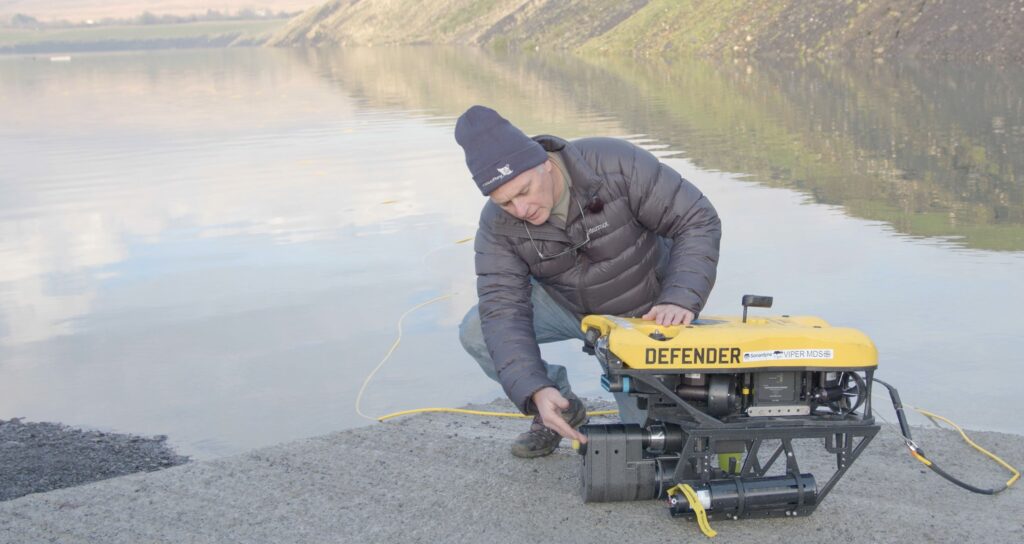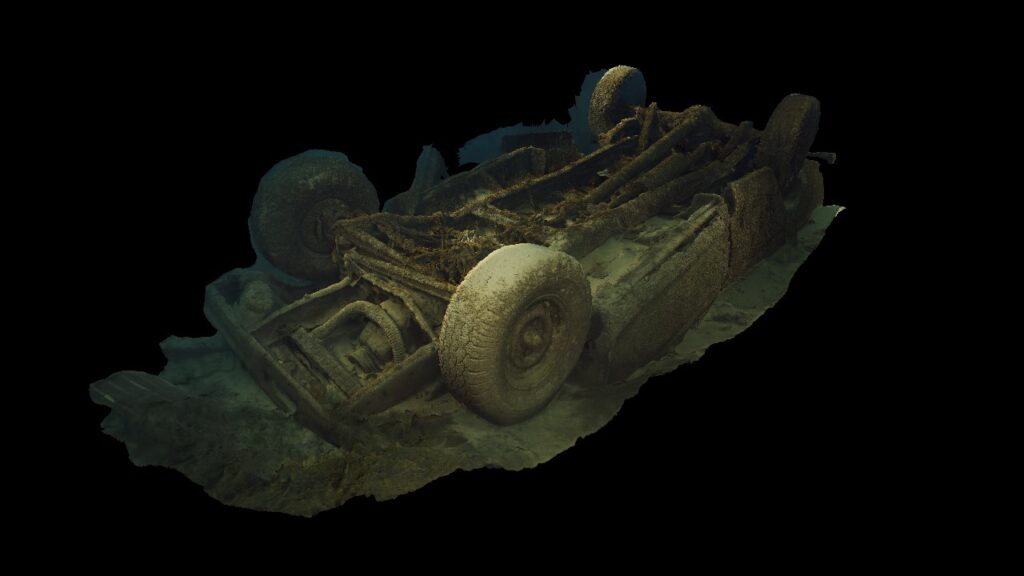Explosive ordnance, such as mines, pose a significant threat to naval operations, offshore energy projects, and other maritime activities. Traditional methods of disposing of these hazards often put personnel and equipment at risk as they require divers or remotely operated vehicles (ROVs) to approach the ordnance closely and manually initiate the detonation process.
The Initiation Transponder 6 (IT 6) from our technology partner Sonardyne, when integrated with mine neutralisation devices mounted on a VideoRay Mission Specialist Defender underwater robot, provides a remote, autonomous, safe and effective solution for mine clearance operations. This technical collaboration allows for acoustic initiation and detonation from a remote location, eliminating the need for and risks associated with physical proximity to the ordnance.
The integration of the Defender and mine neutralisation devices with the IT 6 represents a significant advancement in the field of explosive ordnance disposal (EOD).

How it works:
- The IT 6 is connected to a non-electric mine neutralisation device, which is deployed near the contact by the Defender.
- Once the neutralisation device is in place, the Defender can be manoeuvred to a safe distance, typically around 1 kilometre away.
- Using Sonardyne’s Wideband 2 digital signal technology, the IT 6 receives an acoustic command to arm the charge from a surface vessel or command centre. A subsequent command then initiates the shock tube and detonates the neutralisation device.
- The entire process can be carried out in most weather conditions and during day or night, enhancing operational flexibility and safety.
Benefits:
- Enhanced safety: By eliminating the need for physical proximity to the contact during detonation, the combination of the IT 6 and Defender significantly reduces the risk to personnel and assets.
- Increased operational efficiency: The autonomous delivery and wireless initiation capability streamlines the process, allowing for faster and more efficient mine clearance operations.
- Versatility: The IT 6 and Defender can be used in various underwater environments, including deep-water operations, making it suitable for a wide range of clearance missions. The underwater robot is designed for more precise control of the vehicle position and orientation, heavier payloads and demanding interventions. With seven thrusters, it can move in any direction and maintain active pitch to face its target in an upward or downward orientation.
- Proven technology: Sonardyne’s Wideband 2 digital signal technology draws on a fifty-year heritage; it is field-proven, ensuring reliable and long-range underwater wireless communication. The Defender draws on VideoRay’s twenty-five years of ROV design experience and is built with power, reliability and flexibility in mind.
- Multi-shot: the IT 6 can be fired multiple times, making deck tests and practice runs affordable. In addition, if a mission is aborted the kit can be safely recovered and reused. The explosive charge and the IT 6 are only sacrificed on confirmed contacts.
- Cost: Once the initial investment has been made for the technology, the cost per deployment is significantly lower than sending personnel on each mission. If multiple ROVs are deployed, they can be controlled from one vessel or control room, thus further reducing costs.
Demonstration
In 2022, the IT 6 and the Defender were demonstrated together for the first time to the UK’s Defence Science and Technology Laboratory (DSTL) and the UAE Navy at a quarry in Wales.
The demonstration included successful detonations of a mine neutralisation device, delivered by the Defender and initiated by the IT 6, from a range of approximately 1 kilometre.
As armed forces around the world move towards more autonomous operations on land, in the air and under the sea, there will be increased demand for the utilisation of existing and the development of new technology.
The benefits in terms of safety, efficiency, adaptability and cost are obvious, not just in mine countermeasures; and the collaboration between market leaders, such as Forcys, Sonardyne and VideoRay, will be at the forefront of driving advances in the technology. Contact us to see how we can help you be there too.
_______________________________
Did you know that another of our technology partners, Voyis, manufacture the market’s technically leading ROV piloting camera? The Discovery camera from Voyis enhances your identification by delivering crisp 4K images of your targets in real-time. The ideal complement to the IT 6 and Defender. Find out more in a blog coming soon…
Discovery is a revolutionary new underwater camera system from Forcys technology partner Voyis that is changing the way we understand the underwater domain. In an interview with Luke Richardson VP for Sales and Marketing at Voyis, we discuss the origins of the Discovery, the challenges faced in its development, and the new optical payloads that are helping to transform our understanding of the underwater world.
Discovery was designed to remove the compromise between piloting and inspection cameras. Traditional underwater robotic systems (ROVs) have separate camera systems for piloting and inspection. Piloting cameras are designed with low latency in mind, which compromises the video and data quality of the camera to ensure the pilot has rapid response time. Whereas, inspection cameras provide high quality optical video and imagery, but are not trusted to provide low latency piloting capabilities, limiting the payload capacity for ROVs, particularly smaller platforms. Discovery Vision Systems consolidate these two functions into a single camera system. This gives operators access to high-quality imaging, low latency video feed, and, in the case of the Stereo variant, real-time depth perception, all from a single camera.
Luke Richardson explains, “New optical payloads are providing us with unprecedented insights into the underwater domain. The Discovery’s camera system, for example, uses a mix of high-quality optics and focus, combined with image enhancements done at the edge to generate actionable subsea datasets in real-time. This allows operators to see and understand the underwater world in a new way. It hasn’t been easy. One of the biggest challenges was developing a camera system that could meet the requirements for an effective subsea navigation and inspection tool, while fitting on a small inspection-class ROVs. Discovery Vision Systems are powered with the latest developments in computing capability to minimize the electronic stack, while still performing advanced corrections essential to deliver a superior inspection camera. In addition to optimizing the electronics to get the most out of the camera internals, the system also utilizes a 130° x 130° domed lens with full 4K resolution and crisp focus to provide platforms with increased situational awareness through piloting operations. Integrating this incredible field of view within the Discovery size limitations required mastery from Voyis’ design team. The development of the Discovery tackled the challenges and as a result the quality and capability of the system met the need of our objective, helping humans see the depths like we see the surface.”
In defence applications cameras have a critical role to play in providing improved situational awareness by helping to identify IEDs and mines, supporting autonomous manipulation tasks and obstacle avoidance.
Advanced optical and processing technology readily accessible
Discovery Vision Systems from Voyis use the Data Distribution Service (DDS) architecture to provide users with access to all the data they need to make informed decisions and perform inspections. DDS is a standard protocol that allows different systems to communicate with each other and share data in a real-time and efficient manner.
“You’d like to know why we would want to use DDS? It means we can provide the user with a number of outputs:
- Piloting feed: A live stills-to-video feed that is compressed for low latency.
- Raw image data set: A set of unprocessed images that can be used for further data refinement or inputs to customer proprietary enhancements.
- Processed image data set: A set of images that have been light levelled, undistorted, and colour corrected, optimal inputs for automatic target recognition software.
- Inspection video: A stills-to-video feed to re-live the survey to uncover more details after mission.
- 3D point cloud depth map (Stereo camera): 3D depth perception, mapping the environment to support autonomous manipulation, visual station keeping or docking, and tracking.
Users can simply subscribe to any of these data streams and receive them in real time. This allows users to create 3D models, make decisions, and perform inspections quickly and efficiently.”
Discovery Vision Systems are compliant with the Unmanned Maritime Autonomy Architecture (UMAA) framework, which is used by the US Navy. This means that the system can be easily integrated with other systems that use the UMAA framework. This makes it easy for users to deploy the Discovery Vision System on their own platforms and start using it immediately.

It’s child’s play
“You can’t underestimate the amount of effort that has gone into making the Discovery camera as simple to use as possible. We considered typical survey operations, and wanted to ensure that operators could maintain their general piloting missions without changing tasks or adding additional steps, but also wanted to ensure that the mission would gain a large advantage with the actionable datasets generated in real-time. I am happy to say that we have managed to do that. Discovery is a technical marvel, improving user experience and delivering outputs that are immediately accessible to any user.”
The technical innovations required to make this vision system work are numerous:
- Global shutter: Discovery uses a global shutter, which means that all pixels in the image are captured at the same time. This is important for maritime autonomy applications because it eliminates motion blur and distortion.
- High dynamic range: Discovery has a high dynamic range, which means that it can resolve features in the images with greater detail, whether the target is in very bright or very dark environments. This feature improves identification capabilities.
- 130° by 130° Dome: Discovery has a 130° by 130° Dome that provides very crisp imagery and colours with complete wide-area coverage delivering better situational awareness when performing piloting task or autonomous obstacle avoidance operations.
- High-powered lighting package: Discovery comes with a high-powered lighting package that includes two Nova Minis at 75,000 lumen each allowing the camera to operate in low-light conditions.
Why invest on your camera system?
“The camera is the most important sensor on an ROV. It is what allows you to see underwater without deploying a person. So why would you compromise and only rely on a low-latency camera with limited optimization for subsea environments? If you build the ROV to provide “eyes” in subsea environment for humans ashore, why would you compromise on the camera?,” Luke asks. “In a sense, customers should consider the camera they need to perform their operation before the platform, it is the sensors that enable humans to interpret the subsea domain, the ROV is simply the vessel to transport them.”
If you would like to find out more about Discovery or Voyis other optical systems, please contact us.
